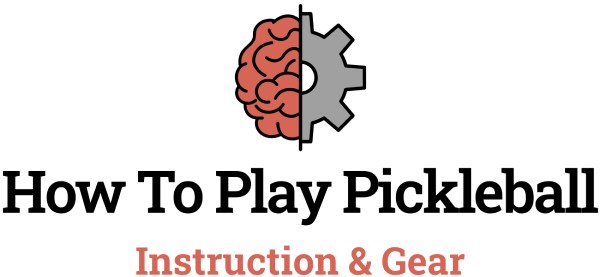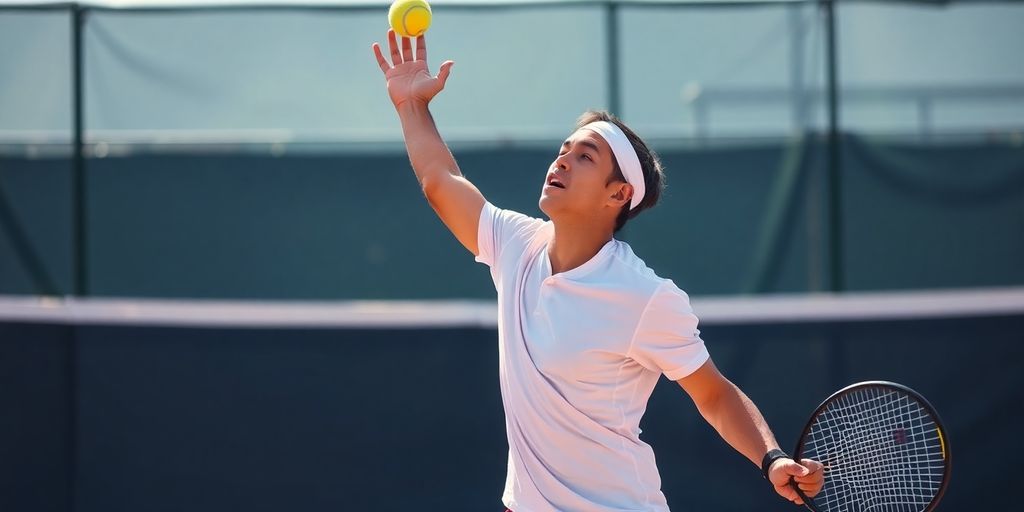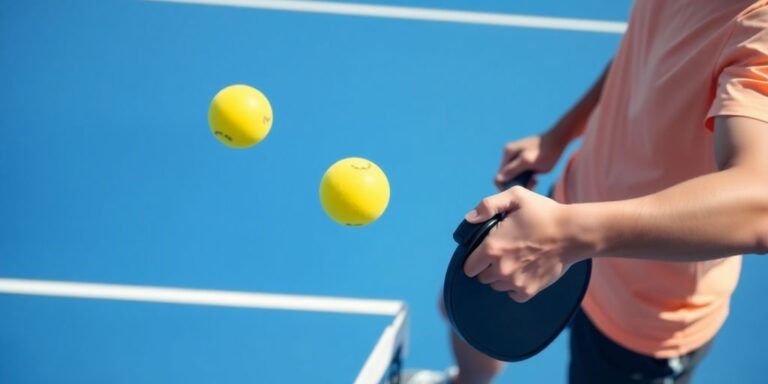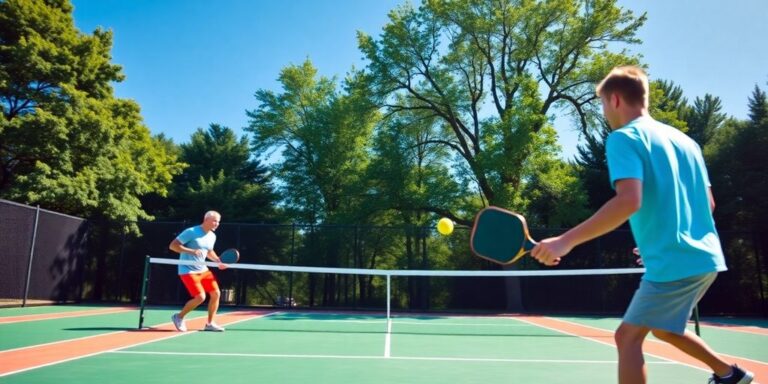Serving in tennis is a game-changer. It can make or break a match, setting the pace and giving you an edge over your opponent. Getting your serve right involves more than just hitting the ball hard; it’s about technique, strategy, and practice. In this article, we’ll dive into some practical tips for serving tennis that can help you elevate your game and become a more effective player on the court.
Key Takeaways
- Master the continental grip for better control and power.
- Focus on a consistent toss to improve serve accuracy.
- Work on footwork to enhance balance and momentum during the serve.
- Incorporate different serve types to keep opponents guessing.
- Develop a pre-serve routine to maintain mental focus and composure.
Master The Grip For Success
Your grip is the foundation of a good serve. It dictates how you connect with the ball and influences the power, spin, and placement you can achieve. Getting it right can feel weird at first, but it’s worth the effort. Let’s break down the essentials.
Understanding The Continental Grip
The continental grip is often recommended for serving, and for good reason. It allows for a natural wrist action, which is key for generating power and spin. Think of it like you’re shaking hands with the racket. The base knuckle of your index finger should be on bevel #2. It might feel awkward if you’re used to other grips, but stick with it. It’s the most versatile grip for serves.
Adjusting Grip For Different Serves
While the continental grip is a great starting point, you can make slight adjustments to influence the type of serve you hit. For example, if you want more topspin, you might slightly rotate your grip towards an eastern backhand grip. This allows you to brush up the back of the ball more easily. Experiment with small changes and see how they affect your serve. It’s all about finding what works best for you and the type of serve you’re trying to execute. Mastering the forehand technique is also important.
Common Grip Mistakes To Avoid
- Death Grip: Holding the racket too tightly restricts your wrist movement and reduces power. Relax your hand and let the racket do the work.
- Using the Wrong Grip: Trying to serve with a forehand or backhand grip will make it difficult to generate power and control. Stick to the continental grip as your base.
- Inconsistent Grip: Make sure you’re using the same grip every time you serve. This will help you develop consistency and accuracy. It’s like mastering pickleball – consistency is key.
A good grip is the first step to a consistent and powerful serve. Don’t underestimate its importance. Spend time experimenting and finding what feels most comfortable and effective for you. It’s an investment that will pay off in the long run.
Perfect Your Toss Technique

Your serve is only as good as your toss. Seriously! If you can’t consistently toss the ball where you want it, you’re going to struggle with power, accuracy, and consistency. It’s the foundation upon which everything else is built. Let’s break down how to get that toss dialed in.
Finding The Ideal Toss Height
Okay, so what’s the magic number? There isn’t one, exactly. It’s more about finding what works for you. The goal is to toss the ball high enough that you can reach it at your full extension, but not so high that you’re waiting forever for it to come down. Experiment! Start with a height that feels natural and adjust from there. A good starting point is about an arm’s length above your fully extended reach.
Toss Placement For Accuracy
Where you toss the ball is just as important as how high you toss it. For most serves, you’ll want to toss the ball slightly in front of your body and a little to your right (if you’re right-handed, reverse if you’re a lefty). This allows you to swing up and through the ball, generating power and spin. If the toss is too far behind you, you’ll end up hitting down on the ball, which kills your power. Too far to the side, and you’ll lose accuracy. It’s a delicate balance, but with practice, you’ll find that sweet spot. A consistent toss is key to a reliable serve.
Practicing Your Toss Consistently
This is where the rubber meets the road. You can read about the perfect toss all day long, but until you actually practice it, you won’t see any improvement. Here’s the deal:
- Dedicated Toss Practice: Set aside time specifically for practicing your toss. Don’t even worry about hitting the ball at first. Just focus on getting that toss consistent. Aim for the same spot every time.
- Mirror, Mirror: Practice in front of a mirror to check your form. Are you keeping your arm straight? Is your release point consistent? Are you swaying or moving your body too much?
- Record Yourself: Film yourself tossing the ball. This can give you a different perspective and help you identify any flaws in your technique. It’s amazing what you can see when you watch yourself on video.
Don’t get discouraged if it feels awkward at first. It takes time to develop a consistent toss. Just keep practicing, and eventually, it will become second nature. Focus on small improvements each session, and you’ll be surprised at how quickly you progress. Remember to master pickleball and tennis serves require consistent practice.
Enhance Your Footwork Skills
Footwork is something that a lot of players don’t think about enough, but it’s super important for a good serve. It’s not just about standing there and whacking the ball; it’s about getting your body in the right position to generate power and control. Let’s break down how to get those feet working for you.
Starting Position And Balance
Your starting stance is key. You want to feel balanced and ready to move. Think of it like a coiled spring, ready to unleash. Most players start with their feet about shoulder-width apart, with the non-dominant foot pointing towards the net at a slight angle. Make sure you’re not too stiff; a little bend in the knees helps. Finding what works best for you is important, but here are some general guidelines:
- Feet shoulder-width apart
- Slight bend in the knees
- Weight balanced evenly
Weight Transfer During The Serve
This is where the magic happens. As you start your serve motion, you’re transferring your weight from your back foot to your front foot. This helps you generate power and drive through the ball. It’s a smooth, fluid motion, not a jerky one. Imagine you’re pushing off the ground with your back leg and transferring that energy forward. This sequential movement is key to a powerful serve.
Footwork Drills To Improve Performance
Okay, so how do you actually improve your footwork? Drills, drills, drills! Here are a few ideas:
- Shadow Serving: Go through your serve motion without a ball, focusing on your footwork and weight transfer. Do this in front of a mirror to check your form.
- Cone Drills: Set up cones in a line and practice stepping towards the net as you would during your serve. Focus on maintaining balance and transferring your weight correctly.
- Agility Ladder: Use an agility ladder to improve your foot speed and coordination. Quick feet are important for adjusting your position during the serve.
Don’t underestimate the power of good footwork. It can make a huge difference in your serve, adding power, consistency, and control. Spend some time working on these drills, and you’ll see a real improvement in your game. Remember, even small adjustments can lead to big results. For example, you can also improve your pickleball serve by focusing on your footwork.
Develop A Fluid Serving Motion

Serving in tennis isn’t just about power; it’s about grace and coordination. A smooth, fluid motion can add consistency and disguise to your serve, making it harder for your opponent to read. It’s like a dance – every part of your body working in harmony to deliver the ball with precision and force. Let’s break down how to achieve that effortless-looking serve.
Relaxation And Tension Management
It might sound counterintuitive, but tension is the enemy of a good serve. You want to be relaxed, not rigid. Think of your arm as a whip – it needs to be loose to generate speed. Before you even start your motion, take a few deep breaths to release any tension in your shoulders and arms. A relaxed body allows for a more natural and fluid swing.
- Shake out your arms before each serve.
- Focus on breathing deeply.
- Visualize a smooth, effortless motion.
Coordinating Your Body Movements
Serving is a full-body exercise. It’s not just about your arm; it’s about your legs, core, and shoulders working together. The key is to synchronize these movements. Start with your legs, transferring your weight as you toss the ball. Then, engage your core as you swing, and finally, let your arm follow through. It’s like a chain reaction – each movement building on the previous one. Proper weight transfer is key to generating power and control.
Importance Of Follow-Through
Your follow-through is just as important as the rest of your serve. It’s the culmination of all your movements, and it helps you maintain balance and control. A good follow-through also ensures that you’re hitting the ball with the right amount of spin and power. Don’t cut your swing short – let it flow naturally until your racket finishes near your opposite hip. This ensures you’re developing a consistent serve and maximizing your potential.
- Extends your arm fully after contact.
- Finishes the swing near your opposite hip.
- Maintains balance throughout the motion.
A smooth follow-through is like signing your name on the serve. It’s the final touch that completes the motion and ensures that you’re hitting the ball with maximum power and control. It also helps prevent injuries by allowing your body to decelerate gradually.
Aim For Precision And Accuracy
Okay, so you’ve got the basics down. Now it’s time to really dial in your serve. Power is great, but what good is it if the ball is sailing out or landing in the net? Let’s talk about how to make sure your serve goes where you want it to go. It takes dedication, and with dedication, you may perfect a serve that is both reliable and accurate.
Targeting Specific Areas On The Court
Don’t just aim to get the ball in. Pick a spot! Think about where you want the ball to land in the service box. Are you trying to jam your opponent with a body serve? Or maybe pull them wide with a serve to the outside? Having a specific target in mind will make a huge difference. To quickly enhance shot accuracy in tennis, focus on adjusting your aim instead of modifying your stroke technique.
Visualizing Your Serve
Before you even bounce the ball, take a second to picture the serve going exactly where you want it. See the ball leaving your racket, arcing over the net, and landing perfectly in the service box. This might sound a little woo-woo, but it really works. It helps you get focused and confident. It’s like a mental rehearsal that sets you up for success.
Practicing Placement Drills
Okay, time to put in the work. Grab a bucket of balls and head to the court. Set up some targets in the service box – cones, towels, whatever you have. Now, try to hit those targets with your serve. Don’t worry about power, just focus on placement. Start slow, and gradually increase your speed as you get more consistent. This is where you really start to build that muscle memory and develop a feel for where the ball is going. Improve your tennis skills by practicing alone with targeted drills. Use cones or a hopper to enhance your serve accuracy by aiming for specific areas in the service boxes.
It’s easy to get discouraged when you’re working on placement. You’re going to miss a lot of serves at first. But don’t give up! The more you practice, the better you’ll get. Just keep focusing on your target, making small adjustments to your technique, and you’ll start to see results. Remember that a successful shot begins with a throw.
Incorporate Serve Variations
Mixing up your serves is a great way to keep your opponent guessing and gain an edge. Don’t just rely on one type of serve; learn a few and know when to use them. It’s like having different tools in your toolbox – each one is suited for a specific job. Let’s explore how to add some variety to your service game.
Understanding Different Serve Types
There are three main types of serves you should know: flat, slice, and kick. The flat serve is all about power and speed. The slice serve curves to the side, pulling your opponent off the court. The kick serve bounces high, making it tough to return. Each serve has its own spin and trajectory, making it effective in different situations.
When To Use Each Serve
Knowing when to use each serve is key. Use a flat serve on big points when you need an ace. A slice serve is great for opening up the court or bringing your opponent wide. A kick serve is useful on second serves to avoid double faults and keep your opponent deep. Here’s a quick guide:
| Serve Type | Best Used For |
|---|---|
| Flat | First serves, big points, trying for an ace |
| Slice | Opening the court, bringing opponent wide |
| Kick | Second serves, high bounce, keeping opponent deep |
Practicing Serve Variations
To really master serve variations, you need to practice them regularly. Don’t just hit the same serve over and over. Spend time working on each type, focusing on the spin and placement. Try these drills:
- Target practice: Aim for different spots in the service box with each serve.
- Mix it up: Alternate between serve types to keep yourself guessing.
- Pressure practice: Simulate match situations and choose the best serve for the point.
Adding serve variations can significantly improve your game. It forces your opponent to adjust and makes it harder for them to anticipate your serves. Experiment with different spins, speeds, and placements to find what works best for you. Don’t be afraid to try new things and get creative with your serves. The tennis serve is a complex stroke kinetic chain.
By incorporating these variations, you’ll become a more versatile and effective server. Remember, the goal is to keep your opponent guessing and control the point from the very first shot. So, get out there and start experimenting with different serves to pickleball quiz and elevate your game!
Maintain Mental Focus During Serves
Tennis isn’t just about physical skill; the mental side is huge, especially when you’re serving. It’s easy to get distracted or feel the pressure, but staying focused can make a big difference. I’ve found that having a few mental tricks up my sleeve really helps me keep my head in the game.
Creating A Pre-Serve Routine
Having a pre-serve routine is like flipping a switch that tells your brain it’s time to focus. It’s all about consistency. Before each serve, I bounce the ball three times, take a deep breath, and visualize where I want the ball to go. This helps me calm my nerves and get ready. It’s similar to how athletes in other sports use pre-match routines to get in the zone. Find what works for you and stick with it.
Visualization Techniques
Visualization is a powerful tool. Before you serve, close your eyes for a second and picture the perfect serve. See the ball going exactly where you want it, feel the motion, and imagine the result. This can boost your confidence and help you execute the serve more effectively. I like to visualize the ball hitting the specific areas on the court I’m aiming for. It sounds a little silly, but it works!
Staying Composed Under Pressure
Pressure can really mess with your serve. When you’re down a break point or serving for the set, it’s easy to get tense. The key is to stay calm. Remind yourself to breathe, focus on your routine, and trust your training. Don’t overthink it. If you start to feel overwhelmed, take a step back, refocus, and remember why you love playing. Top players often use pre-serve routines to handle pressure situations.
It’s important to remember that everyone feels pressure. The difference between good servers and great servers is how they manage it. Don’t let the pressure control you; take control of the pressure.
Commit To Consistent Practice
Okay, so you’ve got the grip down, your toss is looking good, and you’re feeling pretty confident with your serve. But here’s the thing: it all falls apart if you don’t actually practice. I mean, really practice. Not just hitting a few balls before a match, but putting in the time to groove your technique and build consistency. It’s not the most glamorous part of tennis, but it’s arguably the most important.
Setting Up A Practice Schedule
First things first, you need a plan. Winging it just doesn’t cut it. Think about how much time you can realistically dedicate to serving each week. Even 30 minutes, three times a week, is better than nothing. Schedule it like you would any other important appointment. Don’t just say "I’ll practice sometime this week." Actually block out the time in your calendar. Consider what time of day works best for you. Are you a morning person? Or do you prefer to practice after work? Find a time when you’re most alert and focused. This will help you get the most out of your practice sessions. Remember to factor in rest days too. You don’t want to burn out or risk injury by overdoing it. A well-structured practice schedule is key to improvement.
Tracking Your Progress
It’s easy to feel like you’re not improving if you don’t have a way to measure your progress. Keep a log of your practice sessions. Note how many serves you hit, how many went in, and how many were faults. Track your accuracy and power over time. This will give you concrete evidence of your improvement. Video yourself serving. This can be a great way to identify flaws in your technique that you might not be aware of. Watch the videos and compare them to professional players. Are you doing the same things? Are there any areas where you can improve? Consider using a tennis app or a spreadsheet to track your stats. There are many tools available that can help you analyze your serve and identify areas for improvement. Don’t just blindly hit serves. Track your progress and make adjustments as needed. This is how you turn practice into real improvement.
Incorporating Match Simulations
Practicing in a controlled environment is great, but it’s not the same as serving in a match. The pressure of a match can throw off your technique and make you revert to bad habits. That’s why it’s important to incorporate match simulations into your practice sessions. Set up scenarios where you’re serving at different points in a match. For example, practice serving at 30-all, or when you’re down a break point. This will help you get used to serving under pressure. Ask a friend to play a practice set with you, focusing solely on your serves. This will give you a more realistic experience of serving in a match. Try to replicate the conditions of a real match as closely as possible. This includes the noise, the pressure, and the distractions. The more you can simulate match conditions in practice, the better you’ll perform when it really counts. Remember to maintain your pickleball gear so you can play your best.
Consistent practice is the cornerstone of improvement in tennis. It’s not just about hitting a lot of serves; it’s about hitting serves with purpose, tracking your progress, and simulating match conditions. By committing to a consistent practice schedule, you’ll develop the muscle memory and mental toughness you need to serve like a pro.
Here’s a simple table to help you track your progress:
| Date | Serves Hit | Serves In | Faults | Notes |
|---|---|---|---|---|
| 2025-03-20 | 50 | 35 | 15 | Focus on toss height. |
| 2025-03-22 | 50 | 40 | 10 | Improved toss, more power. |
| 2025-03-24 | 50 | 45 | 5 | Consistent placement, powerful tennis serves. |
To truly improve, you need to practice regularly. Just like learning a sport or an instrument, the more you do it, the better you get. Make a plan to practice every day, even if it’s just for a little while. This will help you build your skills and confidence. Ready to take your practice to the next level? Visit our website for tips and resources that can help you stay on track!
Wrap-Up: Elevate Your Serve Game
So there you have it! Serving in tennis isn’t just about power; it’s about technique, practice, and keeping your head in the game. Remember to work on your grip, toss, and footwork—those basics will set you up for success. Mix up your serves to keep your opponents guessing, and don’t forget to stay mentally sharp. With regular practice, you’ll see improvement, and before you know it, you’ll be serving like a pro. Keep at it, and enjoy the journey on the court!
Frequently Asked Questions
What grip should I use for serving in tennis?
The continental grip is the best choice for serving. It helps you hit powerful and controlled serves.
How high should I toss the ball when serving?
You should toss the ball high enough to hit it at the top of your reach, usually around head height.
What is the importance of footwork in serving?
Good footwork helps you maintain balance and generate power during your serve. Start with your feet shoulder-width apart.
How can I improve my serving motion?
Focus on keeping your body relaxed and coordinated. A smooth motion from start to finish is key.
What types of serves should I practice?
Try different serves like flat, kick, and slice. Each type can confuse your opponent and give you an advantage.
How can I stay calm and focused while serving?
Develop a pre-serve routine. Take deep breaths and visualize your serve to help you stay relaxed and focused.




